Anorexia and Ketamine Assisted Psychotherapy - A New Hope
Hey everyone! Today, we’re diving into a critical topic: anorexia nervosa and how an innovative treatment called Ketamine-Assisted Psychotherapy (KAP) is shaking things up. Anorexia is more than just a desire to be thin; it’s a serious mental health condition that can have life-threatening consequences. Let’s break down some facts, explore the brain science behind it, and see how KAP is offering new hope.
The Harsh Reality of Anorexia
Did you know that anorexia has one of the highest mortality rates among psychiatric disorders? It’s true, with rates ranging from 5-20%. Despite the grim statistics, there’s hope: about 33-50% of people do recover with the right support, although it often takes time and ongoing care. Complications from anorexia can affect the heart, bones, and mental health, making it a multifaceted battle.
Physical Effects of Anorexia
Anorexia can have severe physical effects due to prolonged malnutrition. These include:
- Cardiovascular issues: such as heart failure, arrhythmias, and low blood pressure.
- Bone health problems: like osteoporosis, increasing the risk of fractures.
- Reproductive issues: including infertility and amenorrhea (absence of menstruation).
- Neurological effects: including brain atrophy and cognitive impairment.
- Anemia: resulting from reduced red blood cell production.
- General weakness: muscle wasting and severe fatigue.
How Many People Require Eating Disorder Treatment in the UK?
In the UK, it is estimated that approximately 1.25 million people have an eating disorder, with a significant portion requiring treatment for anorexia nervosa. The demand for specialized eating disorder services continues to grow as awareness and diagnosis improve.
Who Is at Risk of Developing Anorexia?
Anorexia primarily affects adolescents and young adults, with a higher prevalence in females. However, males and older adults are also susceptible. Risk factors include genetic predisposition, psychological traits like perfectionism and anxiety, and environmental influences such as cultural pressures to be thin and stressful life events.
Physical Signs of Anorexia Nervosa
Common physical signs of anorexia include:
- Dramatic weight loss and low body weight.
- Abnormal blood counts.
- Fatigue and insomnia.
- Dizziness or fainting.
- Bluish discoloration of the fingers.
- Hair that thins, breaks, or falls out.
- Soft, downy hair covering the body (lanugo).
- Absence of menstruation in women.
Is There a Link Between Anorexia and Health Problems Such as Osteoporosis?
Yes, anorexia is closely linked to osteoporosis. The condition leads to bone density loss due to prolonged malnutrition and hormonal imbalances, significantly increasing the risk of fractures and long-term skeletal issues.
Effects of Anorexia on Fertility
Anorexia can severely affect fertility. For women, it often results in amenorrhea, reducing the chances of conception. Even after recovery, some women may face ongoing reproductive challenges due to the long-term impacts of malnutrition on the body.
Effects of Anorexia on the Heart
Anorexia has significant adverse effects on the heart, including bradycardia (slow heart rate), arrhythmias, and heart failure. The body’s electrolyte balance is often disrupted, exacerbating these cardiovascular issues and posing serious health risks.
Neurological Problems as a Side Effect of Anorexia
Anorexia can lead to severe neurological issues such as brain atrophy, which can cause cognitive impairments and emotional instability. Long-term malnutrition affects brain function, impacting concentration, memory, and overall mental health.
Is Anemia a Side Effect of Anorexia?
Yes, anemia is a common side effect of anorexia. It occurs due to a lack of essential nutrients needed for red blood cell production, leading to fatigue, weakness, and increased susceptibility to infections.
Causes of Anorexia
The causes of anorexia are multifactorial, including:
- Biological factors: Genetic predispositions and neurobiological abnormalities.
- Psychological factors: Traits like perfectionism, obsessive-compulsive tendencies, and high levels of anxiety.
- Environmental factors: Cultural emphasis on thinness, peer pressure, and stressful life events.
Warning Signs of Anorexia
Warning signs include significant weight loss, preoccupation with dieting and body image, withdrawal from social activities, and physical symptoms like fatigue and dizziness. Early detection is crucial for effective intervention and treatment.
Traditional Treatments: A Tough Road
Treatment for anorexia usually involves a mix of medical care, nutritional counseling, and psychological support. For severe cases, inpatient programs provide intensive care. Outpatient programs, where patients live at home but attend regular therapy sessions, are also common. Talk therapies like Cognitive Behavioral Therapy (CBT) and Family-Based Therapy (FBT) are popular, but they don’t always work for everyone.
The Brain’s Role in Anorexia
Now, let’s geek out a bit about the brain! Researchers have pinpointed several brain regions that play a role in anorexia:
- Insula: This area helps process body awareness and feelings of hunger or satiety. In anorexia, the insula can become miswired, leading to distorted body image and disrupted hunger signals.
- Anterior Cingulate Cortex (ACC): The ACC is involved in emotion regulation and decision-making. For those with anorexia, this area can contribute to the intense focus on weight and food control.
- Ventral Striatum: This part of the brain is key to our reward system, influencing motivation and pleasure. In anorexia, the ventral striatum’s reward sensitivity can be off-kilter, making eating less rewarding and restricting more compulsive.
Enter Ketamine-Assisted Psychotherapy (KAP)
Ketamine, originally an anesthetic, is making waves in mental health treatment due to its unique properties. When combined with psychotherapy (KAP), it offers a powerful approach to treating anorexia. Here’s how it works:
- Boosting Neuroplasticity: Ketamine helps the brain form new connections, essentially “rewiring” itself. This is crucial for breaking the rigid patterns associated with anorexia.
- Insula and Body Awareness: Ketamine’s influence can help normalize the insula’s function, improving body awareness and correcting distorted body images.
- ACC and Emotional Balance: By enhancing neuroplasticity, ketamine can help the ACC regulate emotions better, reducing the obsessive focus on food and weight.
- Ventral Striatum and Reward Processing: Ketamine boosts dopamine activity, enhancing the reward system. This makes eating more rewarding and can help diminish the compulsive need to restrict food intake.
A Paradigm Shift in Treatment
KAP isn’t just another treatment; it’s a game-changer. Traditional talk therapies sometimes struggle because they don’t always address the deep-rooted brain patterns of anorexia. But by directly influencing the brain’s neuroplasticity and key regions, KAP offers a fresh, promising approach. Imagine being able to reshape the very circuits that drive anorexia—it’s a revolutionary concept!
Wrapping Up
Anorexia is a tough battle, but with innovations like KAP, there’s new hope on the horizon. By understanding and addressing the brain’s role in this disorder, we’re not just treating the symptoms but getting to the root of the problem. If you or someone you know is struggling with anorexia, remember that help is out there, and new treatments like KAP are providing promising new paths to recovery


